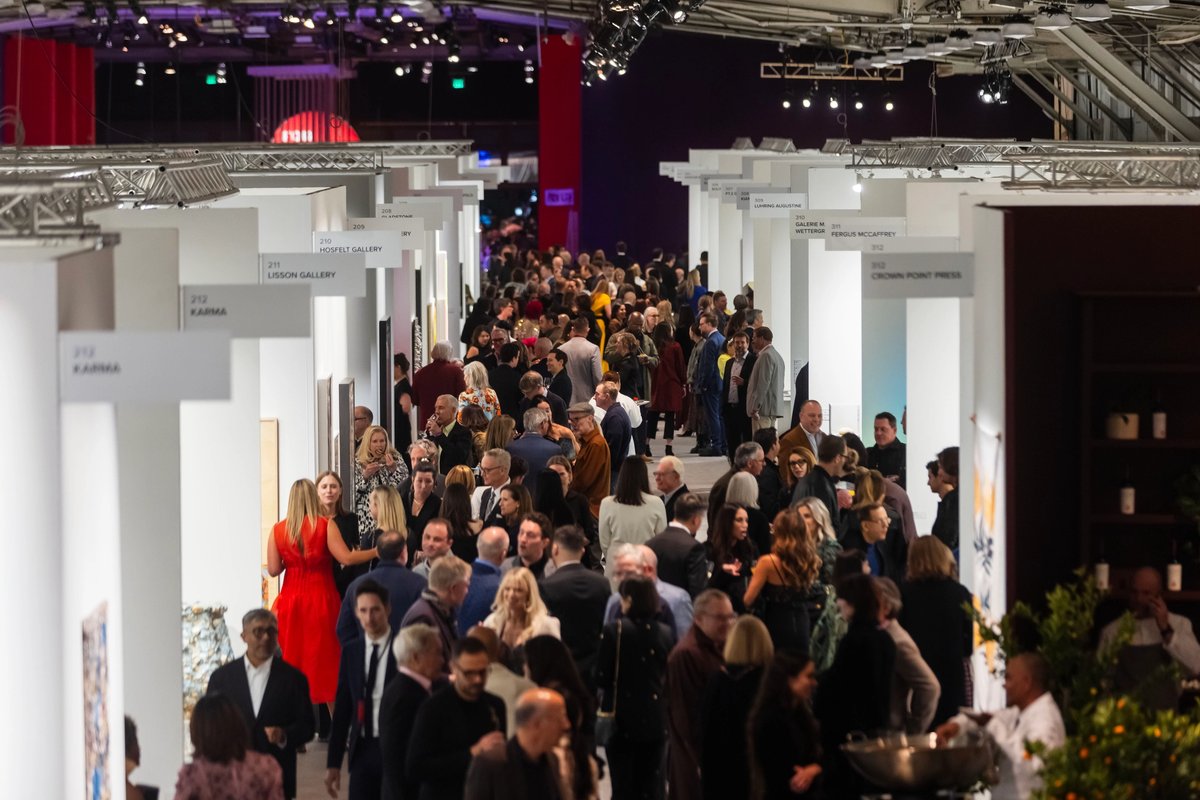San Francisco is beautiful the evening of Fog Design+Art Fair’s 11th annual gala on Thursday (23 January). The fair is located at Fort Mason, a cavernous former military fort made of wood that juts just over the San Francisco Bay, which sparkles until the sun slips beneath the curved horizon line. Inside, more than 2,000 guests have travelled to attend the sold-out opening night preview.
The fair is small enough to see in an hour, but textured and exciting, presenting a full range of works from emerging Bay Area artists to blue-chip artists like Ruth Asawa, Joseph Beuys and Agnes Martin. Spread over two piers, Fog exhibitors include a swath of global galleries, many returning to the fair, along with first-time exhibitors and smaller artist-run spaces. The impressive local showing is in part due to the Fog Focus initiative, which extends invitations to local galleries with offers free or greatly reduced stands. Chris Perez, a member of the steering committee, emphasises “it’s always important for a fair to include local galleries. You have to start there and center that”.
At San Francisco gallery Altman Siegel’s stand, a salon-style hang of Chris Johanson’s work shows off an era of art making in San Francisco’s Mission district alongside a wall-sized painting by Joan Brown. House of Seiko, a gallery run out of a former watch repair store, exhibits a solo presentation by Oakland-based duo Cross Lypka. The artists work collaboratively, passing each piece back and forth, to create iridescent, almost biological ceramic forms rendered in just-off symmetry. At Anthony Meier Fine Arts, pieces by artists integral to the Bay Area’s scene like Saif Azzuz, Libby Black and the late Etel Adnan are on display.
‘The fair has engendered love for the city’
At the fair, the city’s specificity, cultural heritage, working lineages and history of radicalism are on full display Many visiting galleries curated their stands to highlight Bay Area artists, which feels unique at an art fair, where art is so often unintentionally stripped of its context.
“The fair has engendered love for the city with art dealers who come year after year,” says Liz Mulholland of New York’s Andrew Kreps gallery. “Last year was really successful. Successful in terms of sales, but I really feel that this fair is growing in terms of its attendance, and it just keeps getting bigger and better every year.”
The presence of the city’s tech industries felt notably less pronounced than it has in recent years. However, this didn’t affect the fair’s attendance, which was at capacity. Many exhibitors reported excellent opening nights, such as Jonathan Carver Moore, whose presentation of new works by Anoushka Mirchandani sold out entirely.
Hauser & Wirth also had strong opening day sales, selling more than a dozen pieces, including a landscape painting so geometric as to almost feel hallucinatory by Jeffrey Gibson for $100,000 and the 38-year-old artist Avery Singer’s Poker Players (study) for $575,000.
This year, the fair seems to have a “younger, more dynamic gallery selection”, according to Malik Al-Mahrouky, a partner at Mexico City gallery Kurimanzutto, which showed work by Gabriel Orozco alongside artists like Kosovo-born Petrit Halilaj, whose skeletal wire sculptures seem to exist between shadow and structure.
Presented with the notion that there has been a slow decline to the city’s art scene in recent years, Al-Mahrouky says, “Oh, that’s completely untrue. It’s a very sophisticated, well-versed, educated city. And, we have a really close relationship with many advisors in the city”.
Jessica Silverman, who hosts Fog’s best Thursday night party, also reported impressive opening night sales. Highlights include Clare Rojas’s painting Just Take It All (2024) for $90,000 and David Huffman’s painting Earth (2024) for $50,000. Over at her Chinatown gallery, there’s an impressive show of artist Davina Semo’s sonic sculptures: lilting bells that resonate different tones in accordance to their material, internal cavity and length.
A growing art week
Alongside the fair, an extensive art week has developed that encourages local galleries to show off exhibitions at their own locations, as well as host a number of talks, programs and performances. This year, the art guide app See Saw added San Francisco to its roster of cities through February, making it much easier for visitors to navigate the city’s sometimes nebulous scenes.
“San Francisco has all the artists and spaces already, people just have to go to them,” observes Zully Alder, the director of San Francisco’s inaugural Further Triennial.
This year, Fog reintroduced Fog Mrkt, a curated retail space in which local designers and crafts-makers exhibit hand-made materials.
One visitor, who purchased a candle holder made by artist Jesse Schlesinger (represented by Anthony Meier) remarked on her excitement at having actually been able to purchase something at an art fair, and directly from the artist himself.
“One of the things that I really love about this fair is that it brings together both fine arts and more accessible forms of craft and design,” says Janet Bishop, the chief curator of painting and sculpture at the San Francisco Museum of Modern Art (SFMoMA).
The non-profit 500 Capp Street, run out of the former home of artist David Ireland, worked with the artist-run gallery Climate Control to showcase emerging artist work at the market.
“We’re losing art spaces and art schools in the Bay Area,” says 500 Capp Street’s Gui Veloso, “But we are hoping to create spaces that bring people back, or keep them in the city, helping to finance their practices through projects like this.”
- Fog Design+Art, until 26 January, Fort Mason Center for Arts and Culture, San Francisco


